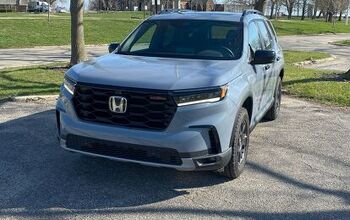Number Crunching: Audi's New Model Naming Process Inspires Confusion, Math

Remember the good old days, back when the numerical part of a car model’s alphanumeric name usually referred to its placement in the lineup or engine size? That went out with powdered wigs and polio. Get with the times. You can’t even count on Mercedes-Benz or BMW to follow through on that anymore.
Audi, however, seems to be blazing a confusing new trail, one that hopefully doesn’t become the norm within the industry. The automaker announced today it will tack an extra number onto existing alphanumeric names, describing not the displacement, not the wheelbase, but the specific vehicle’s power ranking within the model’s range — using a two-digit number (which means nothing on its own) as a signifier of the vehicle’s horsepower.
Prepare to feel nostalgic.
“Within the model families, combinations of two numbers will replace the various type designations previously used,” the automaker announced. “The new designations stand for the specific power output and apply both to cars with combustion engines and to e-tron models with hybrid and electric drives.”
Affecting every model from the tiny, Europe-only A1 to the range-topping A8 sedan and Q7 SUV, the new naming system hasn’t exactly gone over well with the automotive press. Regardless, it looks like the extra numbers are here to stay.
Here’s what to expect. Vehicles generating 109 to 129 horsepower (who wants that?) carry a “30” designation, while those making 147 to 161 hp receive a “35” on the trunklid. 168 to 201 hp? That earns a model a “40.” On and on it goes up the ladder — 45, 50 (55 isn’t confirmed, reports Wards Auto), 60, topping out at 536-plus-horsepower performance models worthy of a “70” designation.
S and RS models keep their existing names under the new system, as does the R8. As well, all models will keep a reference to the engine technology hiding under the hood — TFSI, TDI, e-tron — so buyers know what they’re dealing with. The first model carrying the extra numerical baggage is the next-generation 2018 A8 due out this fall (launched in A8 50 TDI and A8 55 TFSI versions).
So, who dreamed up this plan? The powers that be in Ingolstadt surely didn’t just wake up one morning and decide en masse to fling numbers around like currywurst after a soccer match. Apparently, the company is hoping to get ahead of confusion caused by new technology.
“As alternative drive technologies become increasingly relevant, engine displacement as a performance attribute is becoming less important to our customers,” said Dr. Dietmar Voggenreiter, Audi AG’s board of management member for sales and marketing, in a statement. “The clarity and logic of structuring the designations according to power output makes it possible to distinguish between the various performance levels.”
Get ready to look down your nose at Audis with a lower “score” than yours.
[Image: Audi AG]

More by Steph Willems
Latest Car Reviews
Read moreLatest Product Reviews
Read moreRecent Comments
- SCE to AUX Range only matters if you need more of it - just like towing capacity in trucks.I have a short-range EV and still manage to put 1000 miles/month on it, because the car is perfectly suited to my use case.There is no such thing as one-size-fits all with vehicles.
- Doug brockman There will be many many people living in apartments without dedicated charging facilities in future who will need personal vehicles to get to work and school and for whom mass transit will be an annoying inconvenience
- Jeff Self driving cars are not ready for prime time.
- Lichtronamo Watch as the non-us based automakers shift more production to Mexico in the future.
- 28-Cars-Later " Electrek recently dug around in Tesla’s online parts catalog and found that the windshield costs a whopping $1,900 to replace.To be fair, that’s around what a Mercedes S-Class or Rivian windshield costs, but the Tesla’s glass is unique because of its shape. It’s also worth noting that most insurance plans have glass replacement options that can make the repair a low- or zero-cost issue. "Now I understand why my insurance is so high despite no claims for years and about 7,500 annual miles between three cars.


































Comments
Join the conversation
This is revenge by the marketing dept on the engineers for causing the cheating scandal. Wait 'til you see VW's new scheme!
"Clarity and logic?'' Not so much. Now I'll need a friggin' decoder ring to decipher Audis.